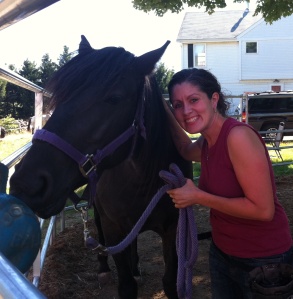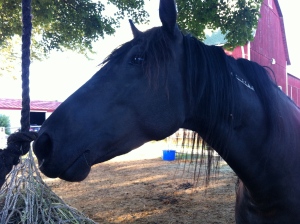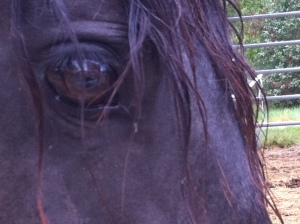 Last week Natalie was able to come out and help me with Aesop a few times, so he had his first two “walk-offs” under a rider. He had a bit of trouble at first bringing his hind legs along with the front of him but he learned how to organize his body fairly quickly. He even had a training session in the snow last Sunday. It was a little slippery but very beautiful. He was relaxed, too, despite the drastic change in scenery and change in footing. Here’s a short clip of our ride in the snow:
Last week Natalie was able to come out and help me with Aesop a few times, so he had his first two “walk-offs” under a rider. He had a bit of trouble at first bringing his hind legs along with the front of him but he learned how to organize his body fairly quickly. He even had a training session in the snow last Sunday. It was a little slippery but very beautiful. He was relaxed, too, despite the drastic change in scenery and change in footing. Here’s a short clip of our ride in the snow:
You might notice that we spend just as much time standing still as we do walking. Whatever you reinforce over and over in a session becomes a “hot” behavior or a target behavior for the learner. It’s important Aesop learns from the very beginning that both walking with a rider and standing quietly with a rider is clickable. To make this easy for him, Natalie asks Aesop for “the grown ups are talking” after each click and treat for quiet, balanced walk-offs. “Grown ups” is one of Alex’s six foundation exercises and something Aesop has known from very early on in his clicker education. This way his training remains balanced and he is not eagerly rushing off without checking in to see what his handler/rider wants. It makes for safe, relaxed horses.
Today we were able to have our third session and in good weather so we worked for longer and refined some of the pieces. Here’s the complete video of our second trial today. Our first one was good, this one is just a bit better:
In this video Aesop is doing a pattern that already familiar to him. He is working “Why would you leave me?” or WWYLM on a cone circle. In WWYLM you ask the horse to walk with you on a circle and to stay bent to you. In the beginning it’s basically loose lead walking for a horse. But it also teaches them about the beginning of bend and how to hold their shoulders upright and eventually, lateral work. Each time he is clicked for walking next to Natalie bent on the circle we stop and she folds her hands to cue him for “grown ups”. We stay in this pattern until the third click for being on the circle at which point Natalie uses her food delivery to turn him around. This way he gets to practice walking in both directions as well as turning under the weight of a rider. Aesop is relaxed and able to offer as good of work under a rider as without which means his training is going at an appropriate pace.
Just because Aesop is doing so well with Natalie at his head and me on doesn’t mean he is ready to be ridden without her. What we are doing right now is essentially habituating him to the feel of a rider while he does familiar work with a ground person. Getting used to the feel of weight. Before we ride off without a header, I still need to transfer the visual cues I have on the ground to tactile cues to be used in the saddle. Most importantly: go forward and stop or whoa. I also need to make sure that Aesop knows how to stretch backward to get food from me when I am on his back. Once I have all of those pieces in place we will be able to ride off without a ground person. Transferring those cues will make up the bulk of our winter lessons and by spring he will have the component pieces of a real riding horse.
I am deeply pleased with how easy this transition has been for him and how operant he has remained throughout this whole process. He’s the kind of horse that feels like a gift from the horse gods – an animal who is calm and relaxed and engaged in all of the puzzles I set out for him.








